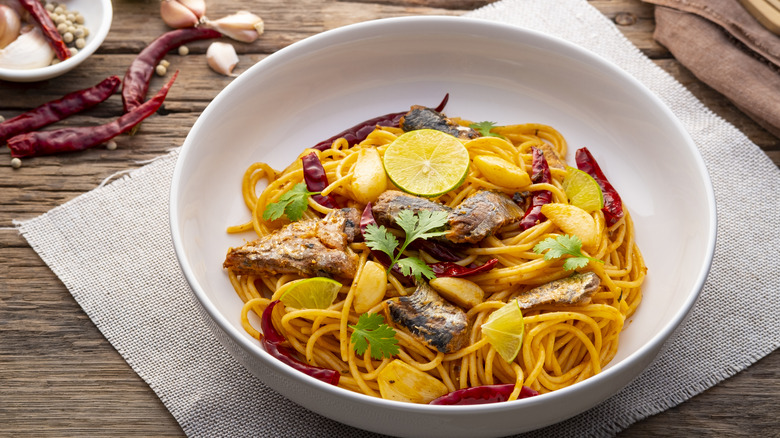When It Comes To Canned Fish, Mackerel Is Totally Underrated
The first cans of mackerel are thought to have been packaged in New England as early as 1843. Fast forward over a century and a half, and the store aisle dedicated to canned goods likely has a tin or two showcasing how far this option has come. Yet, it still seems to lack as much admiration as the abundantly popular canned tuna. It's time to take the reins and give canned mackerel a chance. Its flavor, applications, and nutritional content may surprise you.
Unlike the strong, pungent taste of canned anchovies or sardines, canned mackerel has a much softer disposition. Its fatty flavor is mild yet still lightly imbued with rich umami-ness. Perhaps you're apprehensive about a robust fishy smell hitting your nose as soon as you open the can. Well, that's where canned mackerel is also reasonably restrained, unlike its counterparts. Mackerel also delivers in the nutrition department, as it's packed with omega-3s, protein, vitamins, and minerals. For the cherry on top, this fish is also lower in mercury than tuna. Once you discover the diverse varieties available and have some inspiration to use them, you'll no longer underestimate canned mackerel.
Varieties and how to use it
Packed in rich olive oil, lightly stored in water, heavily infused with smoky notes, or gloriously enriched with roasted garlic — whether you're a fan of complex flavor profiles or plainer canned mackerel, there's a plethora of versions available online and in stores. It's ultimately up to you to decide which variety will work best for your purpose.
The simplest way to enjoy this versatile tinned fish is straight out of the can. With a fork in hand, revel in the juicy, delectable characteristics of canned mackerel without interruption from any other aromas. If you're keen to include another component, layer the fillets between two slices of bread. It's basic, easy, and delicious.
The buttery texture of canned mackerel wonderfully complements pasta, especially when paired with Mediterranean vegetables like olives, peppers, and tomatoes. For less conventional uses, canned mackerel is also a brilliant addition to a charcuterie board. If you're using flavored canned mackerel, make sure to save the oil and use it as a dip for crusty bread.
A more sustainable option?
Over the decades, fish and seafood have been promoted as animal food sources with a lower impact on the environment than land-bound alternatives. However, the effects of overfishing have become noticeable, as reported by the World Wildlife Fund, which claims that a third of fisheries internationally are being overfished. With this knowledge in hand, it's essential to keep an eye out when shopping to identify the logo indicating a canned fish brand is sustainably certified.
So, where does mackerel fall within the environmental sphere? It is generally considered a more sustainably viable option due to its sizeable wild population and its lower position in the food chain. According to the U.S. National Oceanic and Atmospheric Administration (NOAA), due to U.S. regulations, the population of Atlantic mackerel is environmentally managed and responsibly fished, making it a sustainable seafood option.
However, North-east Atlantic mackerel sold in England is caught with a net, making it unsustainable due to overfishing. While figures from the other side of the pond may have little weight in the U.S., they raise an important point about effective ways to prevent overfishing. Hook-and-line caught fishing is more sustainable and should be the top method of harvesting whenever you are selecting products from the sea. Patagonia Provisions canned Atlantic mackerel is harvested by hook-and-line, making it an excellent choice if you seek sustainability.


